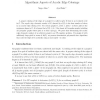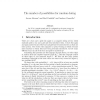59 search results - page 4 / 12 » The Chromatic Number of Random Regular Graphs |
DM
2008
13 years 7 months ago
2008
For any graph G, the k-improper chromatic number k (G) is the smallest number of colours used in a colouring of G such that each colour class induces a subgraph of maximum degree ...
ALGORITHMICA
2002
13 years 7 months ago
2002
A proper coloring of the edges of a graph G is called acyclic if there is no 2-colored cycle in G. The acyclic edge chromatic number of G, denoted by a (G), is the least number of...
EJC
2006
13 years 7 months ago
2006
The general symplectic graph Sp(2, q) is introduced. It is shown that Sp(2, q) is strongly regular. Its parameters are computed, its chromatic number and group of graph automorphis...
SIAMDM
2008
13 years 7 months ago
2008
The first-fit chromatic number of a graph is the number of colors needed in the worst case of a greedy coloring. It is also called the Grundy number, which is defined to be the max...
JCT
2008
13 years 7 months ago
2008
Let G be a regular graph and H a subgraph on the same vertex set. We give surprisingly compact formulas for the number of copies of H one expects to find in a random subgraph of G...


